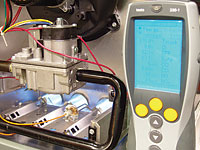
Measured values are usually:
Stack temperature (gross stack temperature) - Temperature of the flue gasses + combustion air temperature.
Calculated values include:

PERFORMING A COMBUSTION ANALYSIS
In general, when performing a combustion analysis, the service technician needs to look at three things:1. Safety.
2. Efficiency.
3. Production of pollutants.
The service technician can rely on the analyzer to perform the calculations needed to determine if the combustion process is efficient, but they must also understand how each of the variables in the combustion process affect safety and appliance efficiency.
Safety: Carbon monoxide (CO) is a pollutant that is readily absorbed in the body and can impair the oxygen-carrying capacity of the blood (hemoglobin). Impairment of the body's hemoglobin results in less oxygen to the brain, heart, and tissues. Even short-term overexposure to CO can be critical, or fatal, to people with heart and lung diseases, the young, or the elderly. It may also cause headaches and dizziness and other significant medical problems in healthy people.
During combustion, carbon in the fuel oxidizes through a series of reactions to form carbon dioxide (CO2). However, 100-percent conversion of carbon to CO2 is rarely achieved under field conditions; some carbon only oxidizes to the intermediate step, CO.
Efficiency: Older furnaces and boilers generally have higher levels of CO than new equipment because older burners were not designed to achieve low CO levels. In today's equipment, high levels of CO emissions primarily result from incomplete combustion due to poor burner design or firing conditions (for example, improper air-to-fuel ratio) or possibly a misaligned burner.
Through proper burner maintenance, inspections, operation, or by upgrading equipment and performing regular inspections (including combustion testing), the formation of carbon monoxide can be limited to an acceptable level.
Pollutants: No standards for CO have been agreed upon for indoor air. The U.S. National Ambient Air Quality Standards for outdoor air are 9 ppm (40,000 micrograms per meter cubed) for 8 hours, and 35 ppm for 1 hour.
No CO (0 ppm) is the best level in the home. This cannot always be achieved due to smokers in the home and/or appliances, like stoves, that are producing acceptable levels of CO during operation. Whenever CO is measurable, the source should be determined and corrective action determined to ensure occupants' safety and minimize the exposure.
The local jurisdiction should be consulted when determining the maximum safe level allowed in the home before shutting down the appliance and/or making it inoperable. An appliance with rising CO production should always be shut down no matter how low CO production is at the time of testing. Rising CO problems are usually the result of improper venting
and/or lack of combustion air.

LIGHT-OFF CO LEVELS
"Light-off" levels of CO have been addressed as an area of concern by many people in industry. Gas and oil appliances have no prescribed maximum CO level at light off. High CO levels at light off may be an indication of rough or delayed ignition warranting further investigation, but they are not considered by manufacturers to pose health concerns due to the short time of higher concentration.The CO readings should peak at less than 400 ppm (there are no prescribed light-off levels), then drop below the prescribed level allowed in the stack. CO readings should stabilize within 10 minutes of operation and should never be rising during operation.
Technicians and manufacturers should be aware that many manufacturers of combustion testing equipment do not filter out the NOx from the combustion sample. NOx can be cross-referenced as CO if not filtered. (Testo analyzers incorporate NOx filters that remove NOx from the CO sample to provide an accurate CO reading.)
If you are using an analyzer that does not filter NOx, be aware that what appears to be unacceptable CO levels may be well within an acceptable range. This is an issue that affects consumers, technicians, and manufacturers alike. Accurate analysis of the fuel gasses is imperative to making proper combustion analysis.
Sidebar: Limits And Levels
AMBIENT CO LIMITS
MAXIMUM EQUIPMENT LEVELS
Vented (CO reading must remain stable):
Unvented (CO reading must remain stable):
Publication date: 01/23/2006

Report Abusive Comment